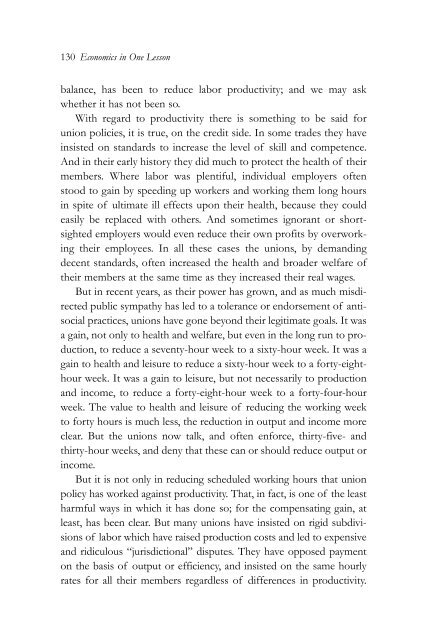1gDdM7w
1gDdM7w
1gDdM7w
- No tags were found...
Create successful ePaper yourself
Turn your PDF publications into a flip-book with our unique Google optimized e-Paper software.
130 Economics in One Lessonbalance, has been to reduce labor productivity; and we may askwhether it has not been so.With regard to productivity there is something to be said forunion policies, it is true, on the credit side. In some trades they haveinsisted on standards to increase the level of skill and competence.And in their early history they did much to protect the health of theirmembers. Where labor was plentiful, individual employers oftenstood to gain by speeding up workers and working them long hoursin spite of ultimate ill effects upon their health, because they couldeasily be replaced with others. And sometimes ignorant or shortsightedemployers would even reduce their own profits by overworkingtheir employees. In all these cases the unions, by demandingdecent standards, often increased the health and broader welfare oftheir members at the same time as they increased their real wages.But in recent years, as their power has grown, and as much misdirectedpublic sympathy has led to a tolerance or endorsement of antisocialpractices, unions have gone beyond their legitimate goals. It wasa gain, not only to health and welfare, but even in the long run to production,to reduce a seventy-hour week to a sixty-hour week. It was again to health and leisure to reduce a sixty-hour week to a forty-eighthourweek. It was a gain to leisure, but not necessarily to productionand income, to reduce a forty-eight-hour week to a forty-four-hourweek. The value to health and leisure of reducing the working weekto forty hours is much less, the reduction in output and income moreclear. But the unions now talk, and often enforce, thirty-five- andthirty-hour weeks, and deny that these can or should reduce output orincome.But it is not only in reducing scheduled working hours that unionpolicy has worked against productivity. That, in fact, is one of the leastharmful ways in which it has done so; for the compensating gain, atleast, has been clear. But many unions have insisted on rigid subdivisionsof labor which have raised production costs and led to expensiveand ridiculous “jurisdictional” disputes. They have opposed paymenton the basis of output or efficiency, and insisted on the same hourlyrates for all their members regardless of differences in productivity.


